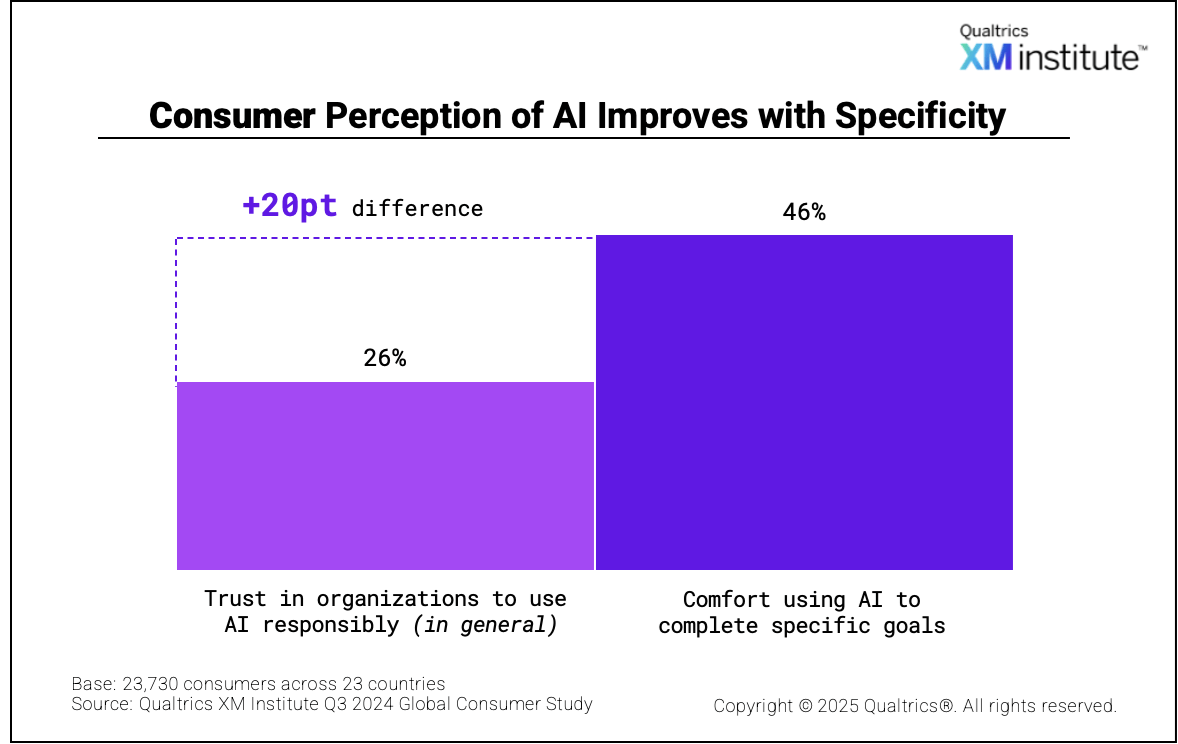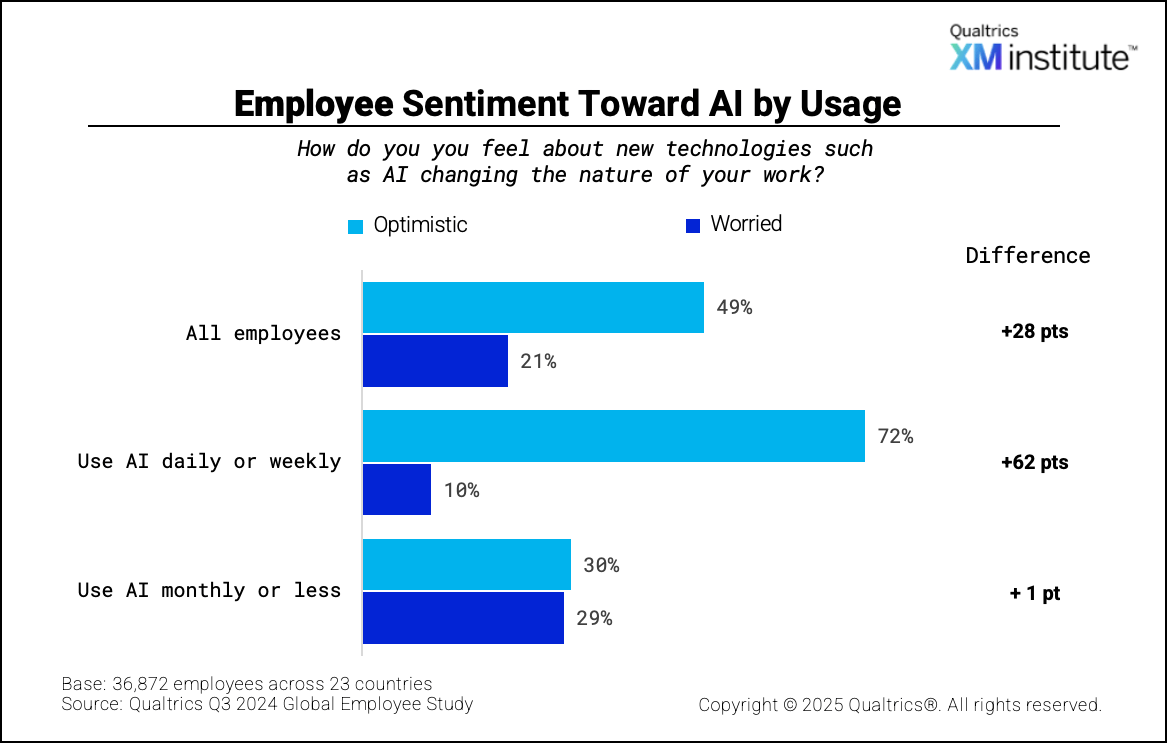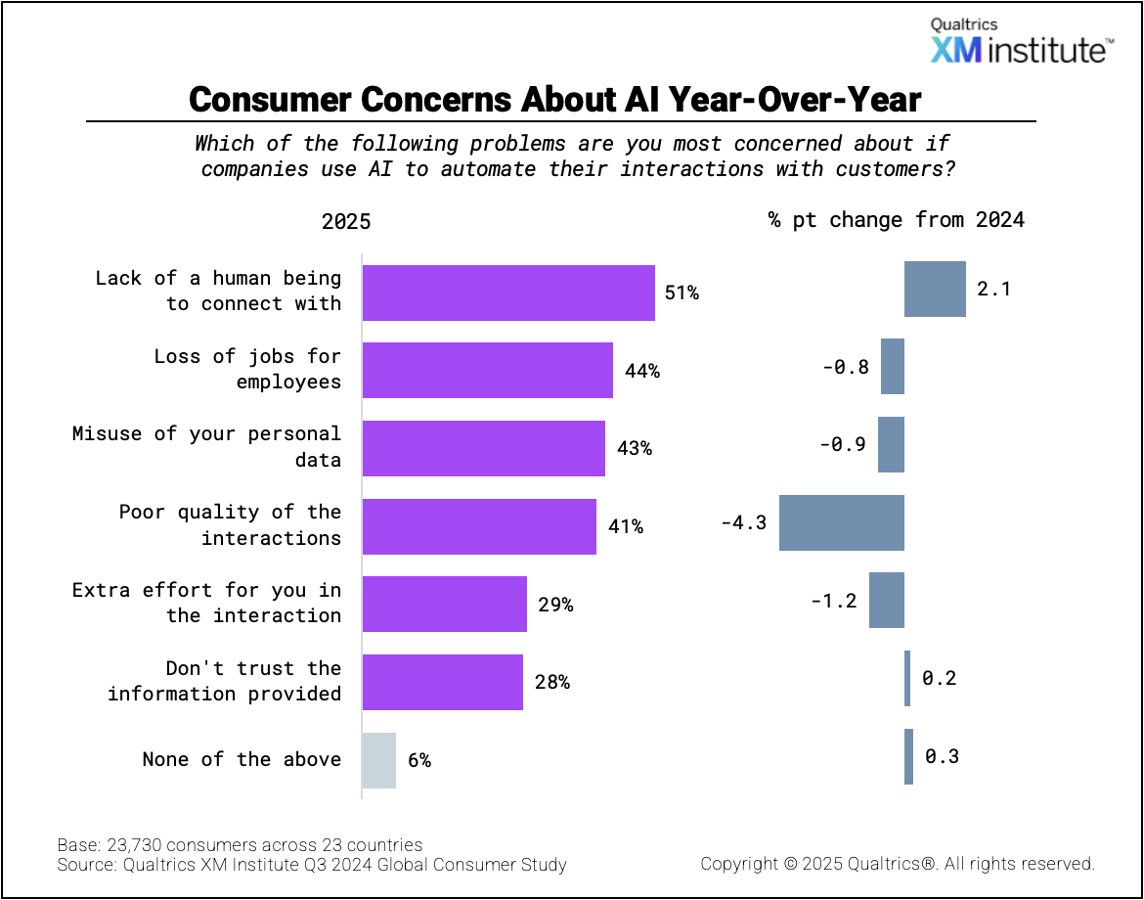AI is everywhere — and most business leaders are optimistic about its potential. But many are still unsure how to lead their organization through the transformation.
Our research of nearly 60,000 consumers and employees reveals that the companies seeing the biggest gains from AI aren’t just chasing automation. They’re designing AI experiences rooted in trust, relevance, and real human connection.
At the end of last year, Qualtrics studied nearly 24,000 consumers and over 35,000 employees across dozens of countries and all major industries about their experiences with AI. What we found was clear: trust, specificity, and a focus on real human connection can determine the success (or failure) of a company’s AI strategy.
Employee & consumer perspectives on AI
As exposure to AI has increased, employees have become more optimistic over time. Today, nearly half of the global workforce (49%) is optimistic about AI while less than a quarter (21%) report being worried about it. Consumers, on the other hand, have grown more concerned with how organizations apply AI. Compared to a similar study conducted a year prior, global consumer comfort with AI dropped a whopping eleven points.
The divergence might appear contradictory. But when it comes to using AI, employees often have much more control than consumers do. Employees, for example, generally have discretion as to whether and how they use AI in their work, whereas consumers have little choice. Unfortunately, just 25% of global consumers trust organizations to use AI responsibly—pointing to a massive experience trust gap. This is a call to business leaders and XM professionals to measure, design, and communicate AI experiences with far more intentionality.
Additionally, both employees and consumers respond more favorably to AI when it’s applied to specific experiences that are explicitly designed for their benefit, such as conducting online searches or streamlining digital experiences. People report more concern (and less optimism) when they consider how organizations apply AI in general.

Finally, it’s also clear that the more people use AI, the more optimistic they are. Although we can’t say whether comfort drives usage or vice versa, it’s clear that people who use AI regularly report far higher levels of comfort and optimism than less frequent users.

Ultimately, both employees and consumers feel better about AI when they can decide how to use it, see a specific personal benefit, and use it with some frequency. All of these point toward ways in which organizations can earn peoples’ trust to achieve mutual benefit from AI.
People value interactions with other people
In our global studies, employees and consumers rated human-to-human interaction as particularly important to their overall experiences. Over half of consumers (51%) are worried that organizations will use AI to replace human-to-human connection. Employees share this concern.

For their part, employees greatly value their interactions with customers. In our study of the global workforce, two of the top five drivers of employee engagement included: processes enable me to effectively meet customer needs and encouraged to develop new ways of serving customers.
The value employees create for customers is clearly an important driver of the employee experience. Similarly, consumers consider their interactions with employees to be massively important to their overall experience, and by extension, their relationship with the brands that employ them. So where does AI play into all of this?
Understanding AI resistance and openness
Despite the fact that humans are exceptional at adapting to change, people predictably respond negatively to the prospect of change. For many employees and consumers, AI represents a monumental change. Sure, there will be eager and early adopters, but many people assume a “wait and see” posture. But just like other technological transformations, we anticipate that with increased exposure, employee and consumer perceptions and usage of AI will increase over time.
As mentioned, people respond positively to specific uses of AI that they have some control over. But when given control, what sorts of experiences do they use AI for? At work, employees are quite comfortable using AI for activities like writing, online search, and data analysis. Sentiment drops sharply, however, when employees are asked about the use of AI to make important social decisions, such as deciding who to hire and promote.
Healthcare caregivers provide further evidence. Physicians and nurses are far more comfortable using AI for administrative tasks (51%) and analyzing patient data (45%), than they are with the idea of using AI to respond empathetically to patients (33%) and listening to patients (28%). Both employees and consumers are pointing to a similar boundary for AI: don’t automate (or eliminate) valuable human-to-human interactions.
Best principles for delivering AI experiences people want
Many organizations are already proving that AI can improve—not replace—the human experience. Here are best principles we can learn from them.
Prioritize Specific, Beneficial Use Cases
General AI messaging triggers skepticism. Focus instead on practical applications that reduce friction, enhance personalization, or save people time.
Give People Some Control
Give people some say-so over how and when they apply AI. Forcing AI usage can backfire while having options can drive organic adoption.
Protect Human- Centered Moments
Don't automate high-emotion or high-empathy experiences. Preserve and elevate your brand's humanity by keeping people in the loop where it matters most.
Design for Trust with Feedback Loops
Track employee and customer sentiment around AI experiences just like you would for any product or service. Use feedback to iterate on deployments and drive adoption over time.
Build Governance into the Experience
Empower people with choice, transparency, and support. Adoption doesn't just require technology—it requires training, ethical frameworks, and clear guardrails.
Best principles in action
Here are a few examples of companies putting best principles to use:
1. Use AI to Enhance Human-to-Human Interactions. For a large restaurant group of brands ranging from quick-serve to fine-dining, the company’s goal is to create real, visceral human connections among servers and their guests. Rather than inserting AI into direct guest interactions, they’ve invested in AI tools that optimize scheduling and operations, freeing up staff to deliver authentic human experiences.
- Best Principles: Align AI applications to your brand promise and invest in solutions that work in the background to enable powerful, human-to-human experiences.
2. Leverage Specific Transactional Applications of AI. A healthcare technology company improved the tedious process of filing reimbursement claims, which had previously been fraught with inefficiencies and errors. The AI tools they implemented dramatically simplified the process for their members - an experience that they want to be quick and easy. Their solution reduced the time spent on claims by 66% and shortened the claims filing process from approximately two days to less than two minutes.
- Best Principles: Use customer (and employee) feedback to identify opportunities for automation and apply AI to specific experiences geared toward customer (and employee) benefit.
3. Provide Governance, Guidance, and Guardrails. One of the immediate challenges organizations face is equipping and educating employees and consumers on AI. Owens Corning, for instance, created a series of trainings for employees giving them fun and practical AI projects to ease them in. ServiceNow, a firm working to integrate AI capabilities throughout the enterprise, has balanced decentralized innovation with a centralized governance structure (what they call “AI Control Tower”) which helps the company track AI use cases, adoption, and outcomes.
- Best Principles: Support employees and customers with guidance and guardrails. Encourage them to start small with specific uses of AI, letting them experience the value firsthand. Guidance is also foundational to building trust, which itself, can impact AI adoption.
The bottom line: Blind automation focused only on speed or savings—without employee and customer input—leads to distrust and churn. But organizations that deliver AI solutions that prioritize employee and consumer experiences, will be poised to dramatically and positively impact business and the lives of their most important stakeholders.
Essential resources to successfully lead your AI transformation
- For business leaders | Experience Management in the Agentic Era (on-demand webinar)
- For CX professionals | Practical examples and ideas on implementing AI solutions (eBook)
- For EX professionals | Guidance on ethical usages of AI in EX (on-demand webinar)



